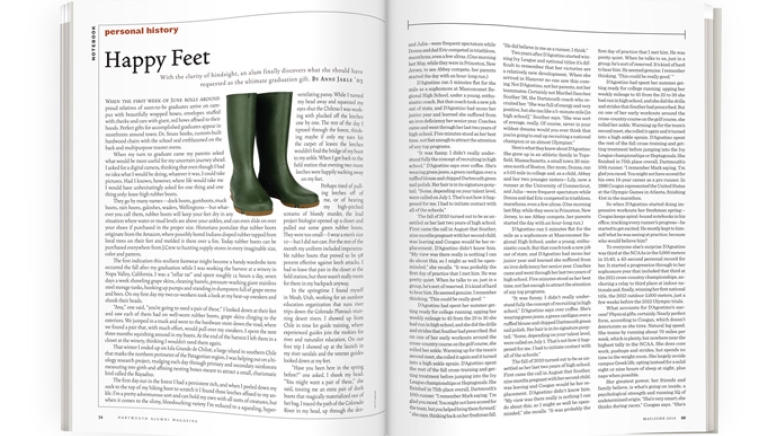When the first week of June rolls around proud relatives of soon-to-be graduates arrive on campus with beautifully wrapped boxes, envelopes stuffed with checks and cars with giant, red bows affixed to their hoods. Perfect gifts for accomplished graduates appear in storefronts around town: Dr. Seuss books, custom-built hardwood chairs with the school seal emblazoned on the back and multipurpose toaster ovens.
When my turn to graduate came my parents asked what would be most useful for my uncertain journey ahead. I asked for a digital camera, thinking that even though I had no idea what I would be doing, whatever it was, I could take pictures. Had I known, however, where life would take me I would have unhesitatingly asked for one thing and one thing only: knee-high rubber boots.
They go by many names—dock boots, gumboots, muck boots, rain boots, galoshes, waders, Wellingtons—but whatever you call them, rubber boots will keep your feet dry in any situation where water or mud levels are above your ankles, and can even slide on over your shoes if purchased in the proper size. Historians postulate that rubber boots originate from the Amazon, where possibly bored Indians draped rubber tapped from local trees on their feet and molded it there over a fire. Today rubber boots can be purchased everywhere from J.Crew to hunting supply stores in every imaginable size, color and pattern.
The first indication this resilient footwear might become a handy wardrobe item occurred the fall after my graduation while I was working the harvest at a winery in Napa Valley, California. I was a “cellar rat” and spent roughly 12 hours a day, seven days a week shoveling grape skins, cleaning barrels, pressure-washing giant stainless steel storage tanks, hooking up pumps and standing in dumpsters full of grape stems and bees. On my first day my two co-workers took a look at my beat-up sneakers and shook their heads.
“Ana,” one said, “you’re going to need a pair of these.” I looked down at their feet and saw each of them had on well-worn rubber boots, grape skins clinging to the exteriors. We jumped in a truck and went to the hardware store down the road, where we found a pair that, with much effort, would pull over my sneakers. I spent the next three months squishing around in my boots. At the end of the harvest I left them in a closet at the winery, thinking I wouldn’t need them again.
That winter I ended up on Isla Grande de Chiloé, a large island in southern Chile that marks the northern perimeter of the Patagonian region. I was helping out on a biology research project, trudging each day through primary and secondary rainforests measuring tree girth and affixing nesting boxes meant to attract a small, charismatic bird called the Rayadito.
The first day out in the forest I had a persistent itch, and when I peeled down my sock to the top of my hiking boot to scratch it I found three leeches affixed to my ankle. I’m a pretty adventurous sort and can hold my own with all sorts of creatures, but when it comes to the slimy, bloodsucking variety I’m reduced to a squealing, hyperventilating pansy. While I turned my head away and squeezed my eyes shut the Chileno I was working with plucked off the leeches one by one. The rest of the day I tiptoed through the forest, thinking maybe if only my toes hit the carpet of leaves the leeches wouldn’t find the bridge of my boot to my ankle. When I got back to the field station that evening two more leeches were happily sucking away on my feet.
Perhaps tired of pulling leeches off of me, or of hearing my high-pitched screams of bloody murder, the lead project biologist opened up a closet and pulled out some green rubber boots. They were too small—I wear a men’s size 10—but I did not care. For the rest of the month my uniform included impenetrable rubber boots that proved to be 98 percent effective against leech attacks. I had to leave that pair in the closet at the field station, but there wasn’t really room for them in my backpack anyway.
In the springtime I found myself in Moab, Utah, working for an outdoor education organization that runs river trips down the Colorado Plateau’s stunning desert rivers. I showed up from Chile in time for guide training, where experienced guides join the rookies for river and naturalist education. On our first trip I showed up at the launch in my river sandals and the veteran guides looked down at my feet.
“Have you been here in the spring before?” one asked. I shook my head. “You might want a pair of these,” she said, tossing me an extra pair of dock boots that magically materialized out of her bag. I traced the path of the Colorado River in my head, up through the desert, along Interstate 70 and to its source in the Colorado Rockies. I pictured the snowpack and dipped my toe in the water. Freezing. We packed up rafts while wading in the water, and once again I felt grateful for my dry and warm feet.
From Moab I moved on to a “real” job, in the communications office of an environmental organization in Old Snowmass, Colorado. I spent much of my day providing information to the public about energy efficiency and renewable energy, and at lunch I would take walks on the 1,000-acre reserve that stretched outside my window. The foundation that managed the land controlled grass height by rotating cows throughout the property to mow it down. One day as I was strolling up the path the land manager approached me.
“Do you mind helping me out for a minute?” he asked. I happily obliged and followed him back to the tool shed, where we hopped on a parked ATV. “Hold on a sec,” he said, jumping off and rummaging around in a cabinet. “You might want these.” He tossed me a pair of rubber boots, and I slid off my summer sandals and forced my feet into the familiar sticky rubber. I spent the next half hour in a muddy field, waving my arms and moving cows.
It is only fitting, then, that the next place I would live would have such respect for the rubber boot that it would have a sport completely dedicated to the supple masterpieces. Gumboots, as the New Zealanders call them, are a national treasure in a land of much rain, many livestock, a multitude of farms and consequently a good deal of mud. In the year I lived there I saw people wearing gumboots in the grocery store, on their farms, at the beach—even at parties. A pair of gumboots is even in the country’s national museum, Te Papa, to memorialize a famous comedian’s caricature of the archetypal “Kiwi bloke.”
In reverence of the footwear, gumboot throwing has become a recognized sport in New Zealand. The rules are pretty simple: You try to throw the gumboot as far as possible. Some towns have official gumboot throwing lanes, where townspeople can congregate to engage in this sport. While not by any means as widely loved or practiced as, say, rugby, gumboot throwing does have its place in Kiwis’ hearts and town festivals.
The rubber boot has firmly established itself in my life as a versatile tool that’s useful in urban and rural settings, domestically and internationally, and in summer or winter. It can be used to keep feet dry and bloodsucking creatures at bay and as an entertainment device. So the next time someone you know graduates, consider foregoing the inspiring marble keepsake or waterproof shower radio and instead giving your loved one a functional gift that’s suitable for any occasion: knee-high rubber boots.
Anne Jakle lives in Laramie, Wyoming, with her husband, Seth Newsome ’99. The most popular rubber boots there feature a camouflage pattern.




